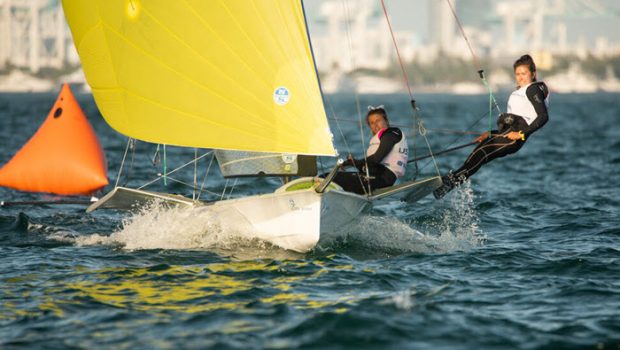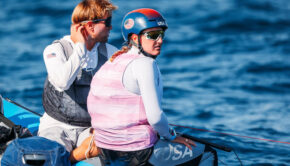Building blocks toward Paris 2024
Published on February 1st, 2021
With the countdown ongoing for the Tokyo 2020 Olympics, a new women’s skiff team of Lucy Wilmot and Erika Reineke are working toward Paris 2024, and their early lessons involve mastering the start.
The approach to the startline for the men’s 49er and women’s 49erFX begins shockingly early, so mastering the ability to hold position, or change position, is vital for success. In this report they share their education from working with US Team 49er crew Hans Henken:
Fully battened sails in the FX gives us the ability to pivot the bow on the starting line. Whichever tack the battens are popped on, that’s the direction the bow wants to swing. However, the goal during the start is to keep the bow from spinning onto either tack (unless executing a bear away or double-tack) and hold it head-to-wind while changing the boat’s drift.
This is where repetition and skill comes into play. The art of starting is all about controlling the battens, maintaining a proper angle of hull heel with body weight, and gauging the force and direction of flow over the foils. If we can master these subtle nuances, then we will be able to hold our position on the starting line and defend our real estate. When the gun goes off, we will be a threat.
Diving further into how to achieve owning your position on the line, there are four basic maneuvers to master.
First, is “forward to slide right.” This entails transitioning from forward flow over the foils into side flow. To do this, we experimented with how much forward flow we needed to execute the maneuver and then how long we could keep the boat creeping to windward in side flow. The skipper must steer up to head-to-wind accurately and prevent the battens from popping. The crew focuses on backing the jib and balancing the angle of heel with body weight to keep the windward wing just kissing the waterline. If all goes well, the hull will creep to windward, close the gap between windward boats and open a space to leeward for the acceleration.
Second, is “slide to backwards.” Here the crew initiates the back up by aggressively pulling on the mast’s lower wires to stop side flow over the foils and increase backwards momentum. Sometimes this will take the crew 2-3 jolts on the lowers to get the boat moving back. Next the skipper inverts the battens (onto port) and pushes the boom out. As the boat starts to lurch backwards, the hull must remain completely flat. Any dip in the wing, can pivot the boat unwillingly. When executed correctly, we can retreat from an unfavorable position on the line and seek out a better option.
Third, is “backwards to an acceleration.” From head-to-wind and backwards flow, the skipper brings the rudder to windward gently arching the bow down to a starboard close-hauled course. Watching the bow intently, the crew is feeling out the precise moment to trim the jib, sneak between the lowers and the mast, heel the boat to leeward and flatten. This timing is a crucial part of the acceleration and getting the boat up to max speed.
Fourth, is the “double-tack.” What is most interesting about this maneuver is that we can enter it with either of three different flow directions over the foils (forwards, side, or backwards). As long as the boat is moving in one of three directions, water is flowing over the foils and we can manipulate the bow’s swing. That being said, without any flow it becomes nearly impossible to enter a double-tack. The crew leads the dance hitting the wing with body weight to guide the bow through the tack and prevent the foils from stalling. Once the tack onto port is completed, the skipper has the option to tack back immediately or swoop down to close the gap on the windward boats.
Capitalizing on these maneuvers, we practiced each one around a buoy for hours at time. Though this was not the most exciting drill, we were willing to put our heads down and get the reps in to develop our skills. Ending the training block with Hans, we saw massive improvements in each area. We went from thinking about how to do the maneuvers to subconsciously executing them. This is what elite level sailing is and we began to get a taste of it on the starting line.
Team information: https://www.wilmotreinekefx.com









 We’ll keep your information safe.
We’ll keep your information safe.